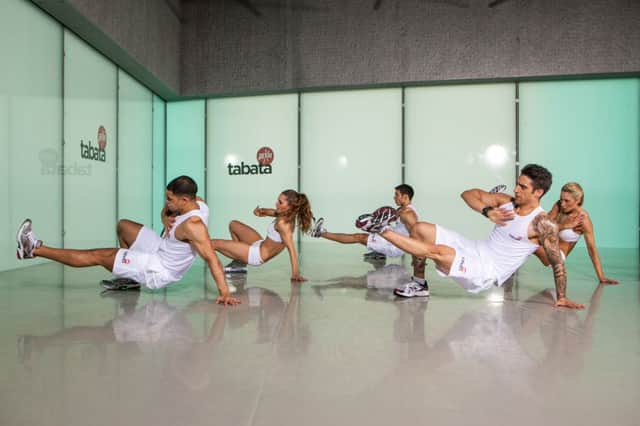Lori Anderson: Careful of HIIT-ting ground running


I still remember the sonorous Klaxon from the public information films designed to educate us about the four-minute Warning heralding our imminent annihilation by the Soviet Union. It practically stopped my heart with fear. Now, 25 years after the end of the Cold War, four minutes as a unit of terror has returned. At the end of the former, one was either burnt to a crisp or condemned to the joys of radiation poisoning, while the latter will only leave you drenched in sweat and gasping for breath.
Leggings, Spandex leotards, “feel the burn” step aerobics and callisthenics – there have always been trends in fitness and 2014 is set to become the year of the four-minute Tabata work-out. Like many of our pop cultural winds, it has blown in from the West, although it actually originates in the East. The annual survey by the American College of Sports Medicine of 30,000 people, which is designed to predict fitness trends, found no mention of Tabata in last year’s top 20, however, this year it comes top of the list. As Professor Walt Thompson of the University of Georgia, who co-authored the report, said: “We’ve never seen something introduced to the market and catch on so fast.”
Advertisement
Hide AdAdvertisement
Hide AdFitness First, the British chain of commercial gyms, is launching classes in London in January before rolling it out across the country to their 180,000 members. Tabata is set to arrive in Scotland on 27 January when the Glasgow Club, the city council’s chain of sports facilities, holds a mass inaugural launch at the Emirates Arena Sports Hall, one of the Commonwealth Games venues in July.
It is claimed the Tabata method is “scientifically proven to be the most effective way to increase both aerobic and anaerobic fitness”. Among the claimed benefits is that it increases the maximum rate of oxygen consumed during exercise by 13 per cent over a six-week period and that if followed correctly the body will consume more calories for up to 12 hours after the class. As their website states: “These are additional calories to those consumed by the body at rest – so over and above the so-called RMB or resting metabolic rate.”
Tabata is a form of what is known as high intensity interval training or HIIT which has been used in various forms by athletes for decades. In the 1970s Peter Coe, the father of Sebastian Coe, drilled his son using a form of HIIT which he had learned from a German coach and a Swedish physiologist. What is curious is that Tabata shouldn’t actually be called “Tabata” but “Koichi”. For in 1996, Irisawa Koichi, the head coach for the Japanese Olympic speed skating team, began to train his athletes in a particular manner. Using a stationary bike, they were to pedal furiously, the fastest they could go, for 20 seconds, followed by a ten-second rest. The process was repeated for four minutes until they had completed eight cycles of sprint and rest. Professor Izumi Tabata was then brought in to analyse the results and he found that it led to improvements in performance. As he said in an interview: “Although Coach Irisawa pioneered the idea, somehow it became named after me.”
Since then, studies have found that short bursts of HIIT can have the same benefits to the body as much longer periods of milder exercise. A study in 2008 found that 2.5 hours of sprint interval training produced the same biochemical muscle changes as 10.5 hours of endurance training. It is claimed new Tabata classes, which consist of a ten-minute warm-up followed by a four-minute routine, will result in the same benefits as an hour on an exercise bike pedalling at a moderate rate. The benefits of Tabata were also promoted by Dr Michael Mosley, the BBC journalist who introduced the wider world to the 5:2 diet. In a documentary in 2012, Mosley revealed that diabetic patients, such as himself, could benefit with the four-minute exercise regime, leading to a significant improvement in insulin sensitivity.
A word of caution to anyone thinking of levering themselves out of the sofa and carelessly scattering the Milk Tray box resting on their belly, with the whimsical intent of launching into a four-minute round of Tabata: don’t. HIIT can result in casualties among those prone to strokes or heart attacks on account of the furious intensity of repeated exertion. Last January, Andrew Marr suffered a stroke after an HIIT session on his rowing machine even though he was exceptionally fit.
Even Professor Tabata urges caution: “Since the exercise is a little bit dangerous for those other than seasoned athletes, I would advise beginners to start at a low intensity, and stay within their comfort zone.
“Once they feel they are getting stronger, they can then increase the intensity little by little.”
Some believe that the benefits from Tabata are derived in the first three weeks and afterwards begin to taper off. Tony Gallagher, a fitness expert, has said it would be “crazy” to take a Tabata class four times a week, adding: “You’ll end up injuring yourself and I doubt it would bring any benefits.”
Advertisement
Hide AdAdvertisement
Hide AdNeither is Tabata or other intensity training exercise the secret to a longer life, at least according to the British Medical Journal which studied 10,000 athletes and discovered that those who participated in high-intensity activities such as cycling, boxing and rowing had a higher mortality rate than those who favoured low-intensity sports such as cricket and golf.
Tabata will appeal to the seasoned exercise enthusiast, hungry to embrace a new challenge. As for me, I’m going to try an online class. That way no-one will see me drop to my knees and crawl under the kitchen table for solace. Maybe the two four-minutes aren’t so different after all.